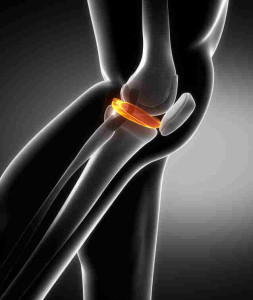If you experience pain in the center or side of your knee, have a limited range of motion, or feel it catching, locking or “giving way,” there could be a tear in a meniscus that requires arthroscopic repair.
Dr. Soffer specializes in the treatment of many sports-related injuries, as well as the open and arthroscopic treatment of knee, shoulder and elbow injuries and artificial joint replacement for arthritis of the knee, shoulder and hip, for residents of Wyomissing, Reading and throughout Berks County, PA. He offers the most advanced treatments and the latest in cutting-edge technology.
What is the meniscus?
 Your knee is made up of three bones: the thighbone (femur), the shinbone (tibia), and the kneecap (patella), as well as the soft tissue that connects them. Between the femur and tibia are two C-shaped pieces of cartilage that cushion the knee, help keep it stable, and act as shock absorbers for the bones. They also allow the joint to slide smoothly and move in many directions.
Your knee is made up of three bones: the thighbone (femur), the shinbone (tibia), and the kneecap (patella), as well as the soft tissue that connects them. Between the femur and tibia are two C-shaped pieces of cartilage that cushion the knee, help keep it stable, and act as shock absorbers for the bones. They also allow the joint to slide smoothly and move in many directions.
These are the menisci (plural of meniscus), and each knee has two of them – one is located at the outer edge (the lateral meniscus) and the other is at the inner edge (the medial meniscus).
Types of Meniscus Tears
When doctors and patients refer to “torn cartilage” in the knee, they may actually be referring to a meniscus tear.
Acute, or traumatic, meniscus tears often occur as the result of an injury, such twisting or hyper-flexing of the knee joint during sports, but can happen during innocuous activities like walking or squatting. A meniscus tear can also occur during an injury to the anterior cruciate ligament (ACL).
Tears come in all sorts of shapes and sizes. There may also be torn or loose pieces of meniscus in the knee joint that cause the knee to slip, pop or lock up. Depending on their severity and size, acute tears may require arthroscopic surgery.
There are also degenerative meniscus tears that result from a lifetime of wear and tear. In degenerative tears, the meniscus often has frayed edges where the tissue has simply worn out. These tears many not produce ongoing pain or discomfort and may not require arthroscopic repair.
Treatment for Torn Meniscus
Treatment for a meniscus tear depends on where the tear occurred (outer edge or inner edge), its severity, and whether other parts of the knee were also injured.
If the tear is small and on the outer edge of the meniscus, your doctor may first recommend resting the knee, applying ice, avoiding activities that aggravate your pain, and over-the-counter pain relievers, instead of surgery. If your knee is not stable and the symptoms interfere with your normal daily activities, arthroscopic surgery can often be done to repair the meniscus.
If your tear is more severe or located on the inner edge of the meniscus where the delicate tissue lacks an adequate blood supply and doesn’t heal well, or you want to return to high-level sports as soon as possible, the damaged tissue may have to be removed with an arthroscopic meniscectomy.
Arthroscopy surgery is one of the most common orthopedic procedures in the U.S. The procedure allows the orthopedic surgeon to see inside of the knee by means of a pencil-sized tube called an arthroscope, which transmits images of your knee through a small video camera to a TV monitor.
Using the arthroscope and tiny instruments, the surgeon can examine the knee and trim away frayed areas, suture torn edges back into place, or remove pieces of the meniscus that may have broken loose.
Dr. Stephen R. Soffer is a board certified orthopedic surgeon who is fellowship trained in sports medicine and arthroscopy by the renowned sports surgeon, Dr. James Andrews. Dr. Soffer’s expertise has earned him inclusion in U.S. News & World Report’s Top Doctor listing for the last five years.
To find out if arthroscopic meniscus repair or another treatment could help resolve your knee pain and discomfort, schedule an appointment today. If you are in the Reading, PA area or elsewhere in Berks County, call 610-375-4949 to find out how Dr. Soffer can help.



